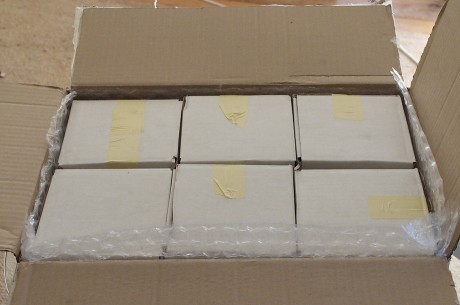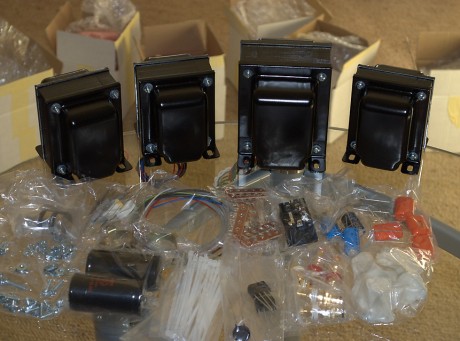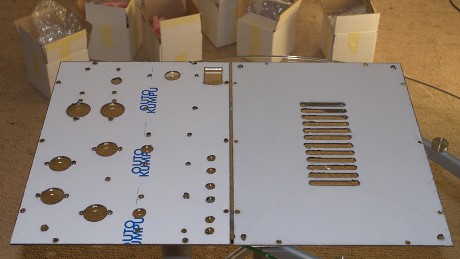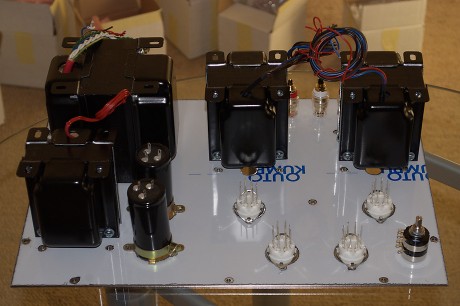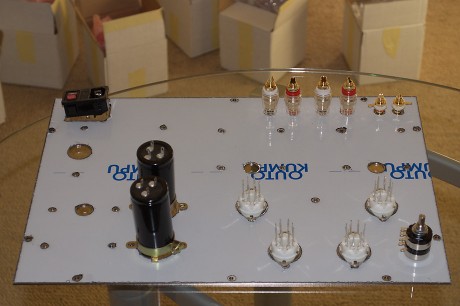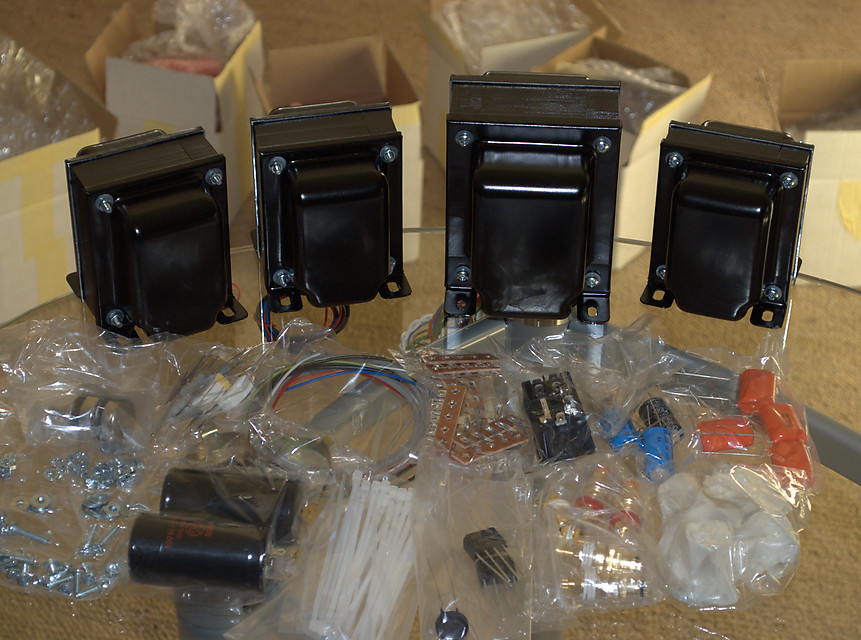
The Weston Acoustics Thunderbird is a kit amplifier from Earle Weston. This is a single-ended amplifier that by default uses two KT88 tubes, but can be biased (by changing the cathode resistor) to several other tube types. I first encountered the amp a couple of months ago at Terry Jones’ get-together in Bathurst, and took a couple of photographs of it. Since I already own one of Earle’s amps (the Trinity Signature), I decided to order and build up the Thunderbird kit as a complement. The topologies of the two amps are quite different (the Trinity is push-pull and valve-rectified whereas the Thunderbird is single-ended and solid-state rectified), and since I’ve never owned a single-ended amp, I thought this was a great opportunity to try one.
Earle emphasizes that this is not a kit for beginners. It is not a “complete” kit, in that it doesn’t include the woodwork for the chassis itself. Nor does it include detailed step-by-step instructions. But it does include pretty much everything else. In other words, you need to have some experience in building amps in order to be able to successfully complete this kit. Earle emphasized to me that he wanted to make sure that anyone who bought the kit was in fact capable of completing it successfully. So if this is your first time around – look elsewhere. But, if you’ve had some experience with building tube amps, can read a schematic, and know your electrical safety, this kit is a tremendous bargain.
This is the first article in a series documenting this build. I’ll be adding a page every fews days as I make progress with the build. Since this is a blog, the articles are in reverse order, so I’ll also be updating this index page with the complete lists of posts related to this amp. Please feel free to use the comment form at the bottom of each article if you have questions that I might be able to answer.
The kit landed (with a thud) on my doorstep last Saturday morning. It’s a hefty box weighing around 10 kg. Those of you who know Earle (or own one of his amps) will I am sure vouch for Earle’s attention to detail, and this is immediately apparent just by opening the outer box:
No just tossing the stuff into a box with a few wads of recycled paper packing here! (Those of you who have purchased from large US-based vendors of electronics parts know what I mean…) Opening each of the little boxes is like Christmas. (Hey, it is Christmas! Or very close to. Thank you Santa.) Let’s see… heavy box – transformer. Light box – parts. All kidding aside, this is as good a delivery as I’ve ever seen.
One of the really wonderful things about Earle’s products is that he makes the transformers himself. Yep – all of them. The first reminder was when I opened the heaviest box, to be greeted by the smell of chemicals. I’m not sure if that was paint or something else, but it was certainly a reminder: these are not parts that have been sitting in some warehouse for years, they were made a few days ago by a bloke down in Victoria. It is so refreshing, in this age of mass production and anonymous call centers in India, to be able to buy a product like this from someone that you know and can call on the phone if you need to.
A word of advice: when unpacking, take care. The transformers are heavy, and the bubble wrap and stuff a little slippery. (No, I didn’t drop anything on my foot, but I will say “I told you so” if you do! Seriously, all I am saying is exercise due caution.)
Here are the parts, not including the chassis plates, after unpacking (click to enlarge):
The iron, from left to right: the output transformers, the power transformer, and the power supply filter choke. They are available in any color you want… as long as it’s black. (Well, Earle might be willing to do them in a different color for an up-charge – you never know, you can always ask him. But for a high-value kit such as this, you’d have to ask yourself if it makes sense.) All of the rest of the parts needed are there – it may not look like a lot, but this is a single-ended amp, a topology that inherently leans to simplicity.
While Earle doesn’t supply a complete chassis with the kit, he does supply top and bottom plates for the chassis. All the kit builder needs to do is construct the chassis itself from four pieces of wood, and the chassis plates can be screwed in. It’s a great way to go and I wish more kit offerings did this. Here are the two plates (click to enlarge):
These are 1/16″ stainless steel. If you have ever hand-punched a chassis plate like this in stainless steel – or even in aluminium – you will realize why I’m calling this kit a tremendous value. (In case you’re wondering, the reason they are white is because that is a protective plastic film – you remove that before mounting the chassis parts.)
By providing the pre-punched chassis plates, Earle has already done most of the hard work for us in laying out the components. Nonetheless, I like to do a quick “test layout” just to see where everything fits. Here is the top plate with all of the above-chassis components sitting on it (click to enlarge):
The power transformer and choke are to the left, and the two output transformers over towards the right. Here is the layout with the iron taken off so you can see the rest of the parts:
One thing you may notice is that everything mounts on the chassis plate: the IEC inlet/fuse/power switch, the input RCA jacks, the output binding posts, and the volume control. By mounting them on the chassis plate, it saves you from having to try and drill and/or route awkward-sized holes in your wooden chassis panels. A thoughtful touch indeed.
Next up: the under-chassis component layout.
